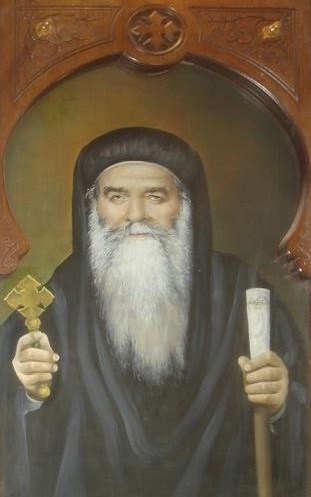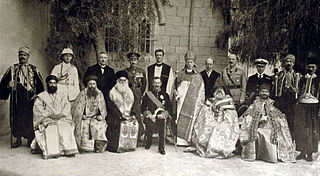
Pope Shenouda III was the 117th Pope of Alexandria and Patriarch of the See of St. Mark. His papacy lasted 40 years, 4 months, and 4 days, from 14 November 1971 until his death.

Pope Cyril VI of Alexandria also called Abba Kyrillos VI, Coptic: Ⲡⲁⲡⲁ Ⲁⲃⲃⲁ Ⲕⲩⲣⲓⲗⲗⲟⲥ ⲋ̅ ; was the 116th Pope of Alexandria and Patriarch of the See of St. Mark from 10 May 1959 to his death.

Saint Simon the Tanner, also known as Saint Simon the Shoemaker, is the Coptic Orthodox saint associated with the story of the moving the Mokattam Mountain in Cairo, Egypt, during the rule of the Muslim Fatimid Caliph al-Muizz Lideenillah (953–975) while Abraham the Syrian was the Pope of the Coptic Orthodox Church of Alexandria.
Cyril III, known as Cyril ibn Laqlaq, was the 75th Coptic Pope and Patriarch of Alexandria.

Pope Cyril V of Alexandria (Abba Kyrillos V), 112th Pope of Alexandria & Patriarch of the See of St. Mark for 52 years, 9 months and 6 days. He was the longest-serving Pope in the history of the Coptic Orthodox Church. He was born as Youhanna (John) in 1824 or 1830/1831 according to different accounts and he died on 7 August 1927.
Pope Peter V of Alexandria was the 83rd Pope of Alexandria and Patriarch of the See of St. Mark from 1340 to 1348.
Pope Benjamin II of Alexandria was the 82nd Pope of Alexandria and Patriarch of the See of St. Mark from 1327 to 1339. His episcopate lasted for eleven years, seven months and 26 days from 10 May 1327 to 6 January 1339.
Pope Athanasius III of Alexandria, 76th Pope of Alexandria and Patriarch of the See of St. Mark.
Pope Gabriel VIII of Alexandria was the 97th Pope of Alexandria and Patriarch of the See of St. Mark.
Pope Mark VII of Alexandria (Abba Marcos VII), 106th Pope of Alexandria & Patriarch of the See of St. Mark. Pope Mark VII was born in the city of Klosna, in the district of El Bahnasa, and his lay name was Simeon. He joined the Monastery of Saint Anthony at a young age, then moved to the Monastery of Saint Paul the Anchorite, where he became a monk and was ordained a priest. When Pope John XVII departed, he was chosen to succeed him. Pope Mark VII was ordained Pope and Patriarch of Alexandria on Sunday, 24 Pashons, 1461 A.M. (30 May 1745 AD) on the day of the feast of the entry of Christ to Egypt.
Pope John XVIII of Alexandria (Abba Youannis) was the 107th Pope of Alexandria & Patriarch of the See of St. Mark from 1769 to 1796. Pope John XVIII was born in Fayoum, Egypt. His lay name was Joseph. He became a monk in the Monastery of Saint Anthony. At the departure of Pope Mark VII, he was unanimously chosen to succeed him. He was ordained at the church of Saint Mercurius Church in Coptic Cairo, on Sunday, 15 Paopi, 1486 A.M. (23 October 1769 AD)

Pope Mark VIII of Alexandria (Abba Marcos VIII), 108th Pope of Alexandria & Patriarch of the See of St. Mark.

Pope Demetrius II of Alexandria, 111th Pope of Alexandria & Patriarch of the See of St. Mark.
Matta El Meskeen, born Youssef Iskandar, was a Coptic Orthodox monk. He was the key figure in the revival of Coptic monasticism, a movement which began in 1969 when he was appointed to the Monastery of St Macarius in the Wadi El Natrun in Egypt. By the time of his death the community had grown from 6 aged monks to 130 monks, and as many other monasteries were revived, new ones also began to open. He was twice nominated to become Coptic Pope, but was not chosen in either case.

The Monastery of Saint Mary El-Sourian is a Coptic Orthodox monastery located in Wadi El Natrun in the Nitrian Desert, Beheira Governorate, Egypt. It is located about 500 meters northwest of the Monastery of Saint Pishoy.

The Monastery of Saint Anthony is a Coptic Orthodox monastery standing in an oasis in the Eastern Desert of Egypt, in the northern part of the Red Sea Governorate close to the border with the Suez Governorate.

The Monastery of Saint Fana is a Coptic Orthodox monastery. It is named after Saint Fana, also known as Bane, Coptic Christian hermit. The monastery is sometimes called the Monastery of Abu Fanah and is also known as the Monastery of the Cross, due to the presence of many beautifully decorated crosses inside its church.

The Holy and Ancient Archdiocese of Jerusalem, All Palestine, and All the Near East or the Coptic Orthodox Patriarchate in Jerusalem, is a Metropolitan Archdiocese of the Coptic Orthodox Church, which is part of the wider communion of the Oriental Orthodox Church. It is headed by the Coptic Orthodox Metropolitan Archbishop of Jerusalem, the incumbent being Metropolitan Archbishop Antonious of Jerusalem since 2016. Its jurisdiction covers those Coptic Orthodox Christians living in the Near East; with churches and monasteries in the State of Israel, State of Palestine, the State of Kuwait, the Hashemite Kingdom of Jordan, the Lebanese Republic, the Syrian Arab Republic, and the Republic of Iraq. The adherents are largely of Coptic Egyptian descent, mainland Coptic migrants and their descendants. The archdiocese is based at St Anthony's Monastery, in the Christian Quarter of the Old City of Jerusalem, beside the Church of the Holy Sepulchre.
Theophilus,, was the 18th metropolitan of the Holy and Great City of Our Lord, Jerusalem, Archbishop of the Holy and Ancient Archdiocese of Jerusalem, all Palestine and the Near East from 1935 until his death in 1945. During his reign, the Archdiocese of Jerusalem also possessed Jurisdiction over the eastern most provinces of Egypt in Al-Sharqyia, Port Said, Ismailia, and Suez. He was also the abbot of the Monasteries of Saint Anthony and Saint George in Jerusalem.











